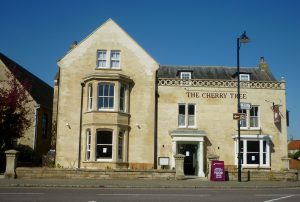
Start Point – The Cherry Tree Restaurant (2018)
This trail presents a ‘light’ introduction to the history of Olney High Street. If you choose to walk this trail, it should take around 45 to 60 minutes.
The wide High Street stretching from the Market Place in the south to the Knoll at its north end is arguably the major feature that makes Olney so attractive and a very desirable place to live. The width is complemented by the various styles of attractive houses intermingled with small stone cottages and traditional business premises. There are many features and stories upon which to comment, some of which are included in this short High Street Trail.
The ‘Start Point’ is the Market Place and in particular the pavement outside ‘The Cherry Tree Restaurant’ formally known as ‘Westlands’. This position provides a good general view of the wide High Street.
Visitors should be aware of how Olneyites describe the direction of travel when walking along the High Street from the Knoll to the Market Place. That is, Olneyites tend to walk in the southerly direction up to the Market Place (ie: up street) and walk in the northerly direction down to the Knoll (ie: down street). Of course, to be an Olneyite your home address at birth must have been within the parish!
.
THE WIDE HIGH STREET
There appears to be no serious research to cite here that fully explains the development of Olney’s wide High Street, but hopefully a reasonable understanding can been gained based on the content of three books written in the recent past by local authors. (See references at the end of this section.)

High Street (Southern End) c.1900
In centuries past, the High Street comprised three elements, the most significant being the stream which flowed down the west side of the High Street with dilapidated banks propped up with wicker work with overhanging willow trees. The stream emerged from Spout Lane (now Spring Lane) and ran in a northerly direction along the High Street until it met another flowing in the opposite direction from Yardley Road at the northern end of the town. They met at a point called the High Arch (believed to be sited somewhere between Millward’s Entry and the Two Brewers Inn), broadly half way down the street, where they joined and flowed eastwards down across the meadow to the river.
(During the great fire of Olney in 1786 many dwellings escaped being completely burnt out because of the proximity of the stream in the High Street.)
The second element was the raised wide pitched causeway that ran down the centre of the High Street, where pedestrians could walk dry-shod when the stream was in flood. The causeway extended from where No. 6 High Street (on the other side of the street) now stands to approximately where the Queen Hotel now stands (one kilometre down the street). It was kept in repair by the Causeway Charity. The causeway was removed in 1790.
The third element was the track for wheeled traffic sited on the east side of the High Street. Together these three elements demanded the wide high street as seen today.
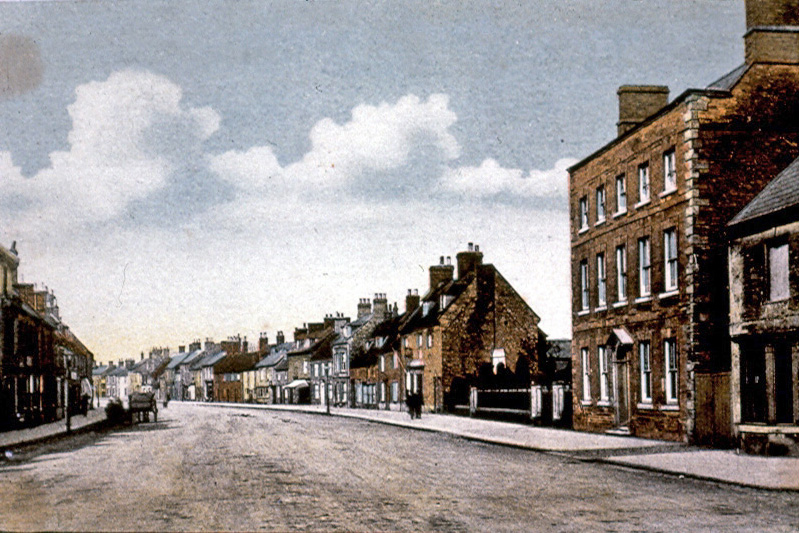
High Street (Upper Central) c.1900
The High Street was lined with stone-built and thatched cottages, with here and there a well built house. It was not until the 16th Century that houses were built in Olney facing the street. Previously the front doors were in Courts or Alleys, as in the 20th Century we recall Aspreys, Berrills, Fields, Floods, Swains, Cobbs, Morgans and Yorks Courts.
Olney was fortunate in that houses could be built from materials found locally; with limestone quarries near to hand, the forests on their doorsteps for oak for the beams and ash for the laths, with straw (reeds) available too for when they began to thatch.
Incidentally, this High Arch was the end of the town’s traditional whipping run which started at the Town Pump (sited close to Costa’s) on the Market Place. This drastic punishment at the cart tail was administered by the Town Beadle and must have been very effective, probably enjoyed by the watching townsfolk and, we hope, an awful warning to the youngsters witnessing the scene!

High Street (Lower Central) c.1900
The street must have looked very picturesque with the stream running down it, but one wonders just how salubrious it was, as there was no waste collection in those days and the temptation must have been quite strong to use the stream as a dumping ground or perhaps as the repository, for example, for the bodies of a dead cat or two. Incidentally, Mr Garrard, a solicitor, was the last person to hold the duck shooting rights for the High Street.
Now fast forward to the present; and let your eyes run along the roofline all the way down the High Street (on either side). The fact that no two houses are at precisely the same level is most noticeable and this certainly adds to the considerable charm of the town. Also, no major houses are exactly alike, and what could be described as almost a mansion stands ‘cheek by jowl’ with a small cottage.
References:
1. Olney Past and Present, O Ratcliff & H Brown, Published 1893.
2. Through the Centuries in Olney and District, S Morgan, Published c.1980.
3. Let’s talk about Olney, J Styles, Published 1981.
Quite where these two streams met and veered east to the River Ouse has always been a little contentious, particularly as several minor parallel streams were still evident in the 1950s that ran eastwards across the meadows between East Street and the River Ouse.
You might suggest another proposal. For example, one alternative route for the Yardley Road stream was to run eastwards from the Knoll down Old’s Lane (now called Holes Lane) and connect with an existing earlier stream that ran adjacent to the ‘cow track’ footpath to the River Ouse. For this proposal to be credible at least some of the water flowing from Spring Lane would need to continue down the High Street to Holes Lane, but it would solve the conundrum of how water ran ‘uphill’ from the Knoll to Millward’s Entry!
.
Moving on to specific buildings in the High Street:
The number of buildings is limited to keep the tour to a reasonable duration. But the project is planned to be ongoing and hopefully buildings will be added or replaced in due course. This means that we are looking for information on other properties in the High Street. If you are in a position to share any such information please contact us at information@olneyhistory.org.uk
Please walk a few metres towards the pedestrian traffic lights on the Market Place and cross the main road. Then head north towards the eastern side of the High Street and take a gentle stroll down the street to the Two Brewers Inn, taking your time to take in the variety of building styles during the stroll.
THE TWO BREWERS INN

The Two Brewers Pub 1953 ERII Coronation Year
The Two Brewers Inn appears to have spent most of its time as two separate properties. A closer look at the ground floor reveals an archway between the two front entrances to the building; the centre of the arch housing the bar area. Until the early 1950s the larger building on the north side housed The Mechanics Institute and the Conservative Club and the smaller building on the south side The Two Brewers Inn (formerly The Queen’s Head).

Olney Fire Brigade (Early 1930s)
In earlier times the archway between them was the primary route for the fire engine to reach the High Street from the Olney Fire Station situated at the rear of property in East Street. After the siren had sounded, summoning the firemen to the station, it must have been exciting to watch the fire engine, with its bell frantically ringing, emerge from the narrow archway into the High Street.
The photographs below of the former The Two Brewers were believed to have been taken in the late 1940s or perhaps the early 1950s. It clearly shows the size of the archway leading from the High Street to the Two Brewers yard, which led directly to the fire station beyond at the bottom of the yard before emerging into East Street. The second photograph, again taken from the High Street, shows a closer view of the archway and particularly the sheet metal tracks used to align a vehicle’s wheels when passing through the archway so as to avoid damage to the walls of the archway.
The above two images were kindly provided by Ann Marie Breeds to whom the ODHS is indebted for permission to display the images on this site.

The ‘Linco’ Stores photo showing the windows that were later blown out by the WW2 bomb
During WW2 on the night of 28th October 1940, a German bomber dropped a fairly large bomb in the meadow on the Clifton Reynes side of the river Ouse adjacent to the railway line. It was, supposedly, intended for the railway bridge which it missed by a couple of hundred metres or so. However, the resulting blast was so severe that, having progressed towards Olney and up the yard of The Two Brewers Inn, it funneled through the archway and completely blew out the two large shop windows of the shop on the other side of the High Street, then called ‘Linco stores’ and now ‘Stephen Oakley Estate Agents’. This bombing incident is recorded in Mr J J Garners WW2 Diaries, reproduced on this website, and confirmed by Bucks County Council’s ‘Bombs over Bucks’ website which reports that 69 properties were damaged that night in Olney and Clifton Reynes.
.
.

QE11 Coronation Festivities 1953
outside the Two Brewers
In the 1950s the Two Brewers developed into a very popular and successful pub under the management of Bob and Ida Ford, possibly because it catered for a broad age range. When they retired in the 1970s, Jack Druce acquired the tenancy and again the pub prospered and arguably continued to be the most popular pub in town under his management. Indeed, the business remains successful to the present day.
(Read more on Olney’s Festivities for the Coronation of Queen Elizabeth 11.)
.
Another very interesting photo below from Ann Marie Breeds showing a manually assembled composite view of four buildings, ie: The Working Mens Club (formally Carlton Lodge), Clifton House, the Olney Mechanical Institute and The Two Brewers.
.
Incidentally, it is well reported that the last reported appearance of the Devil in Olney was at The Two Brewers Inn!
(extracted from Oliver Ratcliff’s book ‘Olney, Bucks’ – originally published in 1907)
The particulars of the last appearance of the Devil in Olney are interesting, showing as they do how completely he was outwitted at last. There is an inn, called the Two Brewers, which he used to visit frequently, causing the host to play the fool and dance at his bidding. Whatever the landlord’s profits may have been, it is clear that his returns must have been seriously affected by the doubtful honour, thus forced upon him, of entertaining such an unlooked for visitor. His patrons were getting fewer and fewer, and they would instinctively shrink from coming in contact with the Devil, though at the same time they might be constant worshippers at his shrine. The situation was quite bad enough as it stood, when the Devil threatened to continue these evil practices, it became necessary to take steps to mitigate or remove the evil.
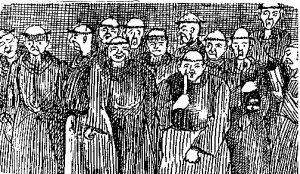
The Thirteen Priests according to Ratcliff
Thirteen priests with bell, book and candle went forth to seek the disturber, and come to terms with him for the relief of the distressed publican. When they met old Clovenfoot, one of the priests, more witty than the rest, asked for a respite of a hundred years. The Devil said he could not grant this, as the term was excessive. But the wily priest was not to be outdone. He had a move in reserve which he thought might prove more successful. He therefore asked “Will you postpone your visits until this candle I hold in my hand is burnt out?” The Devil fell into the trap and answered “Yes”. Thereupon the priest blew out the candle and placed it at the bottom of a well in the yard.
If the re-lighting of this candle is to bring about a renewal of these visits, it is to be hoped in the interests of those concerned, that no meddling busybody will succeed in identifying this well and bringing the candle to light.
.
Walk a few metres further down the street:
CLIFTON HOUSE
Should you have taken this walk in the 1950s, rather than looking at a wooden fence, you would have been confronted by Clifton House, a large Georgian style building (see images) built between the Two Brewers Inn and the Carlton House Club.

Clifton House c. 1950s
Clifton House was a very imposing property on the High Street. Early details of the building, its purpose and its occupants are difficult to come by. In 1891 John Hamp, an Estate Bailiffe, and his wife Elizabeth lived in the house, whereas in 1910 the house was owned by Annie Cooper who resided there.
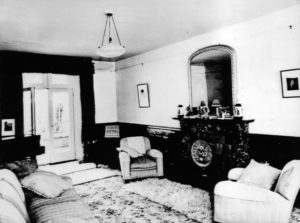
The lounge of Clifton House
c. the late 1940s

Billiard Room and Yew Tree c. late 1940s
By 1936 Horace Cowley, a shoe-factory owner, had moved in there with his family and the family still had a presence there in 1951.

Clifton House c. early 1950s (1)
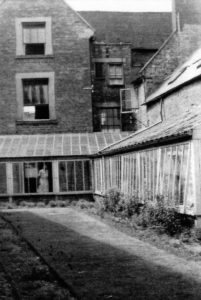
Rear of house c. early 1950s

Clifton House c. early 1950s (2)
Later that decade the building developed substantial structural faults, with major cracks clearly visible on the southern face of the property.
Sadly the building was demolished during the mid to late 1960s. The plot now belongs to the Carlton House Club and performs a useful role as their beer garden. Maybe a different decision would have been taken today resulting in the building being repaired and restored.
A question that could be posed is whether or not this house was built over the stream near the High Arch? If so, this perhaps could have contributed to its demise!
The above images, with exception of the first one, were kindly provided by Mick Carter, a descendant of the Cowley family, to whom the Olney & District Historical Society is indebted for permission to display the images on this web site.
Again, walk a few metres further down the street:
THE UNITED REFORMED CHURCH

United Reformed Church (recent image)
The United Reformed Church is situated next to the Carlton Club and set back a little from the High Street.

The original Independent Chapel built in 1762
In 1762 the Independent Chapel was built on the site. Just above the door is an oval tablet to Ebenezer Abraham, the clockmaker. At that time there were several clockmaking businesses in the town of which Ebenezer Abraham was probably the best known.
This chapel was taken down in 1879, and was replaced in 1880 by a much improved and attractive building. At the same time the opportunity presented itself of securing a frontage to the High Street by purchasing the cottage that blocked the earlier chapel (see the rear yard on the image of the original chapel). The remains of the cottage are clearly visible on the house wall next door (No. 44), above Millward’s Entry . The new chapel was renamed as the Cowper Memorial Congregational Church. It is now known as the Cowper Memorial United Reformed Church.
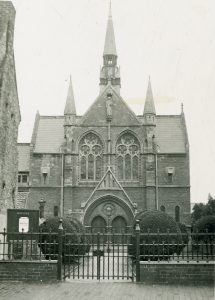
The splendor of the 1879 church
before the 1960s fire
A relatively recent author (see Ref: 3 above) commented that:
‘it seems extraordinary that in spite of all the poverty, that was widespread in Olney for so many years, the chapels of the Independents were constantly improved. In more recent times even when this Church was gutted by fire in the 1960s, it was restored and in use again in a very short time’ (see recent image above). The size of the places of worship in this town is surprising – for hundreds of years the population was under three thousand , so you can’t imagine that anyone had any difficulty finding a seat!’
.
In passing, it is worth noting that Millward’s Entry (next door) is one of the two remaining public passages from the High Street to East Street, the other being Fountain Court. Millward’s Entry is the primary route for pedestrians to access Olney’s extensive sports facilities in East Street.
The Entry is often known as ‘Mill’ards Entry’. Over the years Olneyites have dropped the ‘w’ in ‘Millward’.
.
.
An additional property next door to the United Reformed Church is added for those interested in the design of lace.
No. 44 HIGH STREET – THE HOME OF JOHN MILLWARD

No 44 High Street, 2014
Number 44 (next door) was the home of John Millward, who specialised in lace designs for the crowns of babies’ caps . Around this time the local lacemakers were feeling the effects of the competition from the machine made lace in Nottingham. However, at first, the machines couldn’t copy anything with a round shape such as babies’ caps. So lots of these babies’ caps were handmade and many exported to America. John Millward also gave evidence to Parliament of the piracy of lace pattern designs. He was still winning awards for his designs at the time of the Great Exhibition in 1851.
The image of John Millward, shown on the right, shows him as a tall gentleman, wearing a high ‘stove-pipe’ hat, and the cut-away tailed coat of the day. He had some sort of foot disability and was nicknamed ‘Dabfoot’ in the town!
.
And again, walk a few metres further down the street until you arrive at the Lace Factory:
THE LACE FACTORY

The completed Lace Factory (1928)
The Lace Factory is the last example of a commercial attempt locally to keep the lace industry viable, in spite of the changing economic climate and the vagaries of fashion. It was built by a slightly eccentric character, one Harry Armstrong, who hailed from Stoke Goldington, who employed George Knight to build him in 1928 ‘something the like of which Olney has not seen before’. Here lace which which had been collected from the town and surrounding villages was packed and dispatched all around the world. Lace itself was never made in this building. Unfortunately, the venture came to an end with the death of its instigator.
.

Girls employed at the Lace Factory – July1931
The building was later used for several ventures, the most successful of which was the manufacture of lampshades, before being converted into flats.
(Read more about the history of Lace in Olney and even go on a ‘Lace Walk in Olney’ using the following link to a series of articles by Elizabeth Knight and one (including a short video) by Cis Elderton. )
.
.
.
.
Walk about another 200 metres down the street to Wilson’s Hardware Store:
WILSON’S HARDWARE STORE

Wilson’s Hardware Store (2012)
(new image required)
Gerald Wilson’s ironmongers shop at No.84 High Street is perhaps the only example in the town of a retail business that has consistently grown and developed since it moved into Olney High Street in the 1970s. Although it has a modest frontage in terms of width, inside the visitor is reminded of Dr Who’s ‘Tardis’, as the retail area extends progressively rearwards through a series of sales areas filled with all manner of household goods.
In earlier days (c.1930s – 1970s) the shop was a licensed grocery business owned by the Abrams and then the Riddy families.
.
.
.
.
Walk about another 100 metres further down the street to No. 100 High Street:
THE OLD DOCTOR’S SURGERY

No. 100 High Street – ‘The Doctor’s House’
c.1935 with the surgery and waiting room annex on its right.
Number 100 High Street was the home of the Grindon family, members of which served the town as doctors for at least four generations. Hannah Wilson, who was Mrs Unwin’s niece, figures in the ledgers of the Doctor Grindon of Cowper’s day; and one of the Grindons married Lady Austen’s niece. The doctor’s records also show numerous repeat prescriptions for Cowper and doubtless Mrs Unwin; and the Newtons too, took advantage of his medical skills.
But the Grindons didn’t only dedicate themselves to medicine – we’re told in 1884 when the weathercock was being repaired, in the absence of the steeplejack, Charlie Grindon climbed the spire and twirled the cock around to the amazement of the townsfolk. The steeplejack removed his ladders, but the intrepid Charlie slid down a rope to the cheers of the spectators. Apparently generations of serious ancestors devoted to duty hadn’t entirely eradicated a daring spirit and a sense of fun!
The following images are of the garden of No 100 High Street in the 1930s.



.
A long line of notable doctors followed the Grindons at that address including Doctors Dickenson, Winterbottom and Swallow before the larger medical facility in Cobb’s Garden was opened in 1992.
.
Walk a few metres further down the street to the Zebra Crossing:
LORD’S MALTING

John Lord is generally acknowledged to have developed the first extensive brewing business in Olney. John Lord was presumed to be born in Weston Underwood, date of birth unknown. Records can support that some ‘Lords’ lived in Weston Underwood in the mid eighteenth century. In William Cowper’s time, Samuel Teedon, a friend of the poet and a teacher in Olney, wrote in his diary ‘whilst at Weston, Mrs. Lord brought Cowper some roast beef down from the farm’.
John, his family and close relatives owned some seven public houses, The Boot, The Bell, The Sun, The Duke William, The Cock, The Dolphin and (at the south end of the town) The Red Lion. This malting at 104 high Street was the only one (of five) not attached to a public house. It is possible that the Lord family transferred its malting business to the premises in the High Street after they left the Boot Inn c.1840. An old beam in Lord’s malting has the date 1 August 1835 carved into it, with the two carpenters’ names.
John Lord appears to have been an ambitious brewster. Unfortunately, following his death in 1812, his brewery operations appeared to become fragmented amongst his family. Had the business continued under John, it is possible that it would have expanded further, and as a consequence, it probably would not have been viable for Hipwells to develop their brewery interests in Olney at that time. However, his apparent early death paved the way for them eventually to buy all seven public houses in the 1860s & 70s, and judging by the grand dwellings that the Hipwell’s later built in Olney, there was still a fortune to be made in brewing.
(Read more about John Lord’s Brewery Activities as told by a descendant (another) John lord.)
The three storey malting is Grade II listed as early C19 maltings, altered, stone, slate roof, brick stack. The building has been used for several purposes since it ceased being used as a malting, including the manufacture and storage of lampshades . It now used by a business designing bespoke packaging.
.
Walk along the street a little further to Brock’s Garage:
BROCK’S GARAGE & FARMYARDS
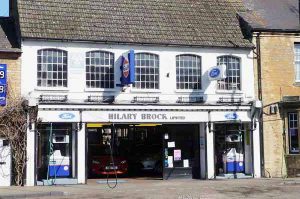
Brocks Garage (2015)
Brocks Garage, a popular garage, closed only recently. Brocks was one of three garages in the town that sold petrol using gantries that swung out over the pavement. The other two garages were Sowmans on the South side of the Market Place, and Souls in High South opposite Alleluia Lamp-post. All three garages sold, maintained and repaired vehicles from those premises from broadly the 1930s to the 1980s – 2010s.
Three earlier farmyards which were fully operational up to around the 1970s are visible from this Garage. The farm buildings on all three sites are now barn conversions. Town Farm (farmed by Longlands then Pibworths) is the large house on the west side of the High Street, Kitcheners farmyard was on the east side almost next door to Brock’s Garage, and Colsons farmyard was in Dartmouth Road (adjacent to the bus shelter). Cows from these farms were driven from the meadows up and down the High Street for milking on a daily basis well into the mid 1950s.

1898 6 hp 2 cylinder Daimler Wagonette Body built by Mulliner of Northampton and owned by the Newport Pagnell Motor Bus Company.
The photo (left) provides evidence that cows did traverse the High Street, albeit in 1898 in this instance, and continued to do so regularly up to the mid 1950s as stated earlier. Unfortunately we cannot identify the cows but the vehicle is a 1898 6 hp 2 cylinder Daimler Wagonette Body built by Mulliner of Northampton and owned by the Newport Pagnell Motor Bus Company.
It is also worth noting that the buildings visible in the image on the west side of the High Street remain structurally unchanged after 120 years. (photo taken from an upstairs window of the ‘corner shop’ on Dartmouth Road).
.
.
.
.
When the traffic permits please take care and crossover the High Street to Town Farm, a more favourable position to talk about the Knoll:
TOWN FARM
‘Town Farm’ is an C18 Grade II listed property and is a splendid example of an in-town farmhouse and farmyard. The entrance to the farmyard was on the north side of this extensive property.

Town Farm
.
THE KNOLL
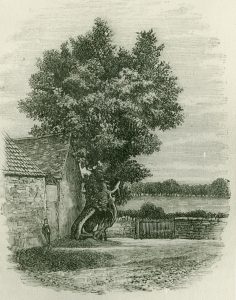
The Churchyard Elm (from a photograph)
Past local historians have suggested that in the northerly direction well beyond the Knoll a castle, or a monastery of sorts, stood on the Whirly Pits side of Yardley Road. However, with a little more certainty, before the parish church was re-built in its current position in the 14th Century, a church once stood not too far behind the Knoll. Evidence in the form of human remains found when digging out the footings the Feoffee Cottages in Dartmouth Road, together with the existence until the 1950s of an elm tree known as the Churchyard Elm opposite the Queen Hotel, suggests that this northern end was once the most important part of the town. There are no records to indicate why the church moved to its current site although, of course, theories abound!

Olney Railway Station in 1911
Moving along the time-line a good bit, a couple of centuries ago, the northern end of Olney, with the exception of a handful of properties, ended at the Knoll. Beyond the Knoll today is predominantly the development that came with the coming of the railway. The building of the new streets was intended to accommodate the number of workers that would use the railway to work outside the town, probably in Northampton or Bedford. In reality most, particularly office workers, used buses as the frequency of the trains was in sufficient for their needs. As it happened most properties were let, initially at least, to shoe industry workers as the majority had workshops, even mini factories, built at their rear which could be used by the tenants, as outworkers, to service the larger factories in the town.

The Knoll c.1900
In the 20th Century at the north end of the Knoll stood two buildings (see image). The building on the left was the Castle Inn, a very popular inn after WWII when managed by ‘Auntie’ and ‘Uncle’ Fred Lyon. It was the only pub in the town that was not owned by brewers Hipwells (and later Phipps, a Wellingborough brewery). It was not a ‘free house’ but owned by NBC, the Northampton Brewery Company. (No such thing as ‘guest beers’ in those days.)

The Knoll c.1910
The building on the right was a blacksmith’s workshop which continued shoeing horses well into the 1950s. The last blacksmith was Alistair Bull who lived ‘over the shop’. The Castle Inn was substantially extended into its current form after the demise and demolition of the smithy. The premises have since been fitted out as an Indian restaurant called ‘The Maya’.
In the coloured image above, note the lighter coloured track just in front of the cyclist and lamp post. There were two such tracks across the High Street, one at each end, which were apparently kept clean so that the ladies did not soil the hems of their clothing with mud, or even worse!

Olney Silver Band on the Knoll -1899
The photograph on the left was taken by George Lett in 1899 of Olney Silver Band preparing to play on the Knoll, obviously on a Sunday as everyone was turned out in their ‘Sunday best’ clothes. George Lett probably took the picture from an upstairs window in Number 12 Beauchamp Terrace – then the home of Harry Lett. (Note the cottages in West Street – demolished a good few decades ago!)
The Knoll was not surfaced at that time (incidentally neither was the Market Place) and it is common knowledge that the surface was far from flat owing to children using it on a regular basis to play marbles!
In past decades the Knoll could have been described as a mini Market Place at the North end of the town. Today it is essentially a traffic island but is occasionally pressed into service, e.g, as a Sunday market on ’Dickens of a Christmas Day’.

The Knoll c.1948
An image of the Knoll circa 1948 on the right shows no structural or environmental changes over the 50 years since 1899, except for converting the Knoll itself into a garden. But who would have thought that after another 50 years the A509 road, now a ‘trunk route’ with numerous very heavy vehicles and commuters speeding past this junction to Milton Keynes and the M1, would completely shatter the peaceful nature of this part of town.
.
.
.
Now on the return to the Market Place, walk some 150 metres up street to The Olney Centre:
THE OLNEY CENTRE (FORMERLY OLNEY PRIMARY SCHOOL)

The Olney Centre (2015)
The Olney Centre was, unsurprisingly, a former school which, during its existence from the 1920s to the 1970s, went through a series of names, such as Olney Council School, Junior School and Primary School.
(Read more on early schools in Olney between 1775 and 1917 as researched and presented on this website by Elizabeth Knight. Elizabeth has yet to cover the sectarian National School (C of E) which used the Church Hall or the British School (non-conformist) which was built in Weston Road next to the Ann Hopkins Smith Almshouses. These schools are recorded as covering a period up to 1915. However, we are still a little unclear as to early history of this school.)
This school was the only ‘council’ school in town until the Senior School at the top of Yardley Road/ Moores Hill was built around 1930. At this time the school became Olney Junior School/ Olney Primary School and accommodated children in seven classrooms, around 35 in a class, between the ages of rising 5s to 11 years. The infants, aged from 5 to 7 years, occupied the three classrooms at the front of the building, whilst the juniors, aged 8 to 11years, occupied the four classrooms towards the rear of the building. The classrooms ran off the school’s central Main Hall.

Photo taken in the ‘boy’s playground’
During a period in WW2, children and their teachers from London were evacuated to Olney to take refuge from the blitz. The consequential pressure on classroom space forced the school to run a double day shift, the locals attending school in the morning and the evacuees in the afternoon. Apparently the children didn’t complain about attending school for only half the day!
Incidentally the smart structured garden in the front of the building was developed from the infant’s playground. Two playgrounds were provided at the rear of the building to separate the junior boys from the girls which now act as a car park for the Centre.
After new additional schools were built to cater for the increase in Olney’s population in the 1960s and 70s the school was closed and later developed into the very successful town community centre it has now become.
.
Walk about another 100 metres further up the street to Cobbs Garden:
89 TO 93 HIGH STREET – COBBS GARDEN (AND THE BAKEHOUSE)

A photograph taken from inside Cobbs Gardens (c. 1920s)
looking east towards the archway in the High Street

The archway leading to Cobbs Gardens
Through the archway was Cobbs Garden, one of the best known ‘courts’ of tenement buildings in the town, comprising some ten or more small cottages often housing large families (see image). The houses were demolished in the 1960s and have since been replaced by the NHS Cobbs Garden Surgery.
You will note that next door to the archway is a bakery, which once belonged to Freddie Richardson and then Alf Harrison (now Sandwich Land). The bakehouse at its rear could only be accessed through the archway. On Sunday mornings in the 1930s and 1940s housewives, who had neither gas or electric cookers with which to cook their Sunday roasts and Yorkshire puddings, walked their assembled roasting tins covered with a tea towel through the archway to the bakery oven. This baker took in some 50 to 70 roasting tins every Sunday morning which were collected from 12 o’clock onwards for a charge of about 1p.
.
Walk about another 100 metres further up the street to No 79 High Street:
OLNEY’S ‘NEW HALL’ AND ‘ELECTRIC CINEMA
( Extracted from a letter written in the early 1990’s by Percy Wright on the subject of Olney’s ‘Electric Cinema’. Read Percy’s full account of Olney’s cinema on this website.)

Sowmans Staff Dinner in the New Hall

Senior Citizens Dinner in the New Hall
Mr Lewis Thompson, who was an Olney grocer trading at 9 High Street in the early twentieth century, had a hall built to be used for concerts, meetings and dancing; and having a stage the hall became very popular. Often at Election Meetings it could get a little rowdy with opposing supporters almost coming to blows. The building was called ‘The New Hall’ and it was used by the townspeople for a good few years.
Some years later, in 1919, it was bought by Mr Clifford, who converted the front of the building to form a cinema. The front of the building stood a few metres back from the pavement with two steps leading up to the two front doors. Inside was a vestibule with a ticket office on the right hand side. The projection room was built over the front porch, with an outside staircase leading up to it. The first proprietor was Mr Clifford. His wife was known as ‘Madam’ Clifford.

The film being shown was the 1927 ‘King of Kings’
– a silent film directed by Cecil B de Mille
– an iconic film of its day.
The seats installed near the screen were more like forms. Behind them came the wooden single tip-up seats and then a few rows with padded seats. The seats at the rear, just inside the left hand side of the hall, were plush padded with arm rests, and the floor for these had been made a little higher so that people could look over the heads of those in front.

The well-published postcard/photograph taken outside the cinema around 1920
In the early days, since there was no sound to accompany the film, when a performance was ready to begin, ‘Madam’ Clifford walked, much like a Duchess, down to the piano. When she was sitting comfortably on the piano stool the cinema was plunged into darkness and the projectionist, Mr Chapman, started the performance by turning a handle to feed the film through the projector. As the story unfolded ‘Madam’ Clifford would play very softly and slowly for a sad scene, and fast and loud for galloping horses or cowboys and indians fighting.
In the cinema’s later years when silent films were long gone, Mr Webster was the proprietor, Mrs Pettit the cashier and refreshment sales and Alistair Bull was the projectionist. The cinema closed in the early 1950s.
Subsequently the building has been used for shoe manufacture, a photographic studio and for some time now, a beauty and fashion boutique.
.
Walk about another 50 metres further up the street to No 67 & 69 High Street:
ORCHARD HOUSE – NOS 67 & 69 HIGH STREET

Recent photograph of Orchard House
Orchard House was converted from two eighteenth century houses in 1904 for Joseph William Mann; the architect was Alexander Ellis Anderson. J W Mann was at that time Olney’s largest employer, having moved to Olney from Northamptonshire in 1880, founding a shoe factory there in 1884 with his partner, William Hinde. J W Mann was not only of some standing in the town as a local manufacturer and employer, but also seems to have been a generous local benefactor, as well as being involved in bringing social and economic improvements to the town in the early twentieth century.

Joseph Mann & his wife Harriet
It is not clear when J W Mann purchased Nos. 67 and 69 High Street. Early Ordnance Survey maps show that they were two properties in 1882 but were already one by 1900, although very different in plan to the present. It is recorded that Orchard House was the first house in Olney to have electricity, which was powered by a generator housed in a small brick building in the garden.

The Drawing Room
J W Mann was not only an astute business man but also a meticulous dresser. He was a familiar sight walking down the middle of the High Street from Orchard house to his large factory on the corner of Midland Road dressed in his bowler hat, silver topped cane and grey spats over his Hinde and Mann shoes.
Use the link to read much more about the history of Orchard House – Nos 67 & 69 High street – the families that lived there, and J W Mann’s boot and shoe business.
.
.
Walk about another 200 metres further up the street to No 15 High Street:
NO 15 (OLNEY HOUSE) & 15A HIGH STREET

Nos 15 and 15A High Street
No 15 Olney House and 15A are listed as Grade II, C18 altered, stone and roughcast, slate roof of modern Mansard form with three flat topped dormer sash windows. This large and imposing building was separated into two properties in the 1950s. The larger property No 15 was called Olney House and modified for commercial purposes. The smaller property No 15A was called Evelyn House after Evelyn Allen, who lived there in her retirement. Evelyn was the daughter of Archibald Allen, one of the two founder solicitors of the Garrard & Allen partnership.
Garrard & Allen have practised in Olney for over 200 years, since its foundation in 1796 – possibly earlier – by John Garrard.
According to the 1910 Revenue Survey, Archibald Allen owned No 15 High Street, together with six additional properties and various plots of land in Olney. The 1911 Census lists the household as consisting of Archibald Allen aged 55, his wife Emily (or Maud?) aged 42, and his daughter Evelyn aged 18.
Incidentally Archibald Allen’s partner John Garrard lived next door at No17 High Street. The 1891 Census lists John Garrard aged 87, an unmarried Solicitor at No 17 High Street. The 1936 Register of Electors has Frederick William Bull and William Sharman Bull (possibly solicitors) residing there, suggesting that the main Partnership was practicing somewhere else in the High Street.
After the building was divided into two properties, No 15 became an office for Soul Securities and subsequently was used both for financial services companies and general office accommodation.
Garrard & Allen moved to No 4 High Street on the other side of the street some decades ago and has since expanded substantially with respect to the services it provides.
.
Walk about another 50 metres further up the street to No 9 High Street:
No 9 HIGH STREET

Portrait of
Mr T T Coles
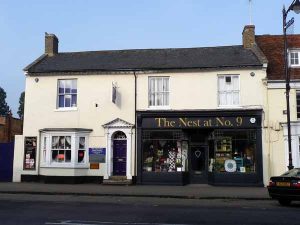
No 9 High Street (2013)
This listed Grade II C18 building has probably spent a good deal of its life as a successful grocery store. The 1891 Census has Thomas T Coles living at No 9, as a grocer and wine merchant, with his wife and family. As both Thomas’s father, Benjamin Coles (1795 – 1855), and grandfather, Daniel Coles (1762 – 1827) were Olney grocers is is conceivable that No 9 had been in the family for some years.
The 1910 Revenue Survey indicates that, although Thomas Coles still owned the property, he had moved into Springfield House, a rather large property in Yardley Road (now known as Broomfield, a residential home).
Lewis Thompson ran the business at this time as a Provision Merchant. The 1910 Survey also shows that Lewis Thompson owned some 22 houses/cottages in the town. This was the same, previously mentioned, Mr Thompson, who had the ‘New Hall’ built for concerts, meetings and dancing; later to become Olney’s cinema. Mr Thompson retired to ‘Ivy Cottage’ a large house in Midland Road.
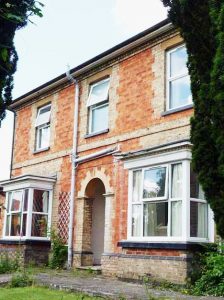
Springfield House now Broomfield

Staff working at the ‘Inters’ as it was known locally
The shop was later managed by national grocers ‘International Stores’ for some years until probably the rapid growth of supermarkets in the surrounding large towns. This store together with the Co-op store across the road were arguably the two most successful grocers in the town during the 1950s.
In the 1980s the shop was managed by building societies including the Woolwich Bank for some 30 years or so, whilst the remainder of the building was given over to offices and healthcare facilities. In recent years the shop has operated as a successful ‘modern’ gift store called ‘The Nest at No 9’.
Continue walking up the street to the junction with Spring Lane:
SPRING LANE
Spring Lane was extremely narrow before No 3 High Street – previously Clark’s butchers shop and then Markham’s antique shop – was demolished and Spring Lane widened in the 1950s. It was just about wide enough for the passage of one horse and cart! You will observe that it is not exactly wide now, and you will remember that – as its name implies – it had a significant stream flowing down it before the stream entered the High Street. There’s a thought to finish with!

Spring Lane and Westlands (now Cherry Tree Restaurant) c.1910
.
WE ARE BACK WHERE WE STARTED, SO WHAT NEXT?
On behalf of the Olney History Society and the Cowper and Newton Museum, we trust that you have enjoyed your self-guided stroll around Olney High Street. If you did not have an opportunity to visit the C&N Museum before starting this walk then please consider a visit to this amazing heritage attraction today or in the very near future.
And finally, you will have noticed that this walk has conveniently ended within a few steps of a dozen or so restaurants, coffee shops and cafes. Why not make your selection and enjoy!
Last modified January 2020.
Copyright © 2018 Olney & District Historical Society




